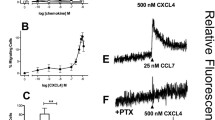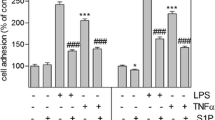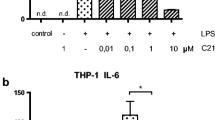Abstract
Migration of CD4-positive lymphocytes into the vessel wall is a critical step in atherogenesis. Recent data suggest that CD4-positive lymphocytes express the nuclear transcription factors Liver-X-Receptor (LXR) alpha and beta with an effect of LXR activators on TH1-cytokine release from these cells. However, the role of LXR in lymphocyte migration remains currently unexplored. Therefore, the present study investigated whether LXR activation might modulate chemokine-induced migration of these cells. Stimulation of CD4-positive lymphocytes with SDF-1 leads to a 2.5 ± 0.8-fold increase in cell migration (P < 0.05; n = 12). Pretreatment of cells with the LXR activator T0901317 reduces this effect in a concentration-dependent manner to a maximal 0.9 ± 0.4-fold induction at 1 μmol/L T0901317 (P < 0.05 compared to SDF-1-treated cells; n = 12). Similar results were obtained with the LXR activator GW3965. The effect of LXR activators on CD4-positive lymphocyte migration was mediated through an early inhibition of chemokine-induced PI-3 kinase activity as determined by PI-3 kinase activity assays. Downstream, T0901317 inhibited activation of the small GTPase Rac and phosphorylation of the myosin light chain (MLC). Moreover, LXR activator treatment reduced f-actin formation as well as ICAM3 translocation to the uropod of the cell, thus interfering with two important steps in T cell migration. Transfection of CD4-positive lymphocytes with LXRα/β siRNA abolished T0901317 inhibitory effect on MLC phosphorylation and ICAM3 translocation. LXR activation by T0901317 or GW3965 inhibits chemokine-induced migration of CD4-positive lymphocytes. Given the crucial importance of chemokine-induced T cell migration in early atherogenesis, LXR activators may be promising tools to modulate this effect.





Similar content being viewed by others
References
Al-Aoukaty A, Rolstad B, Maghazachi AA (1999) Recruitment of pleckstrin and phosphoinositide 3-kinase gamma into the cell membranes, and their association with G beta gamma after activation of NK cells with chemokines. J Immunol 162:3249–3255
Arber S, Barbayannis FA, Hanser H, Schneider C, Stanyon CA, Bernard O, Caroni P (1998) Regulation of actin dynamics through phosphorylation of cofilin by LIM-kinase. Nature 393:805–809
Bernhagen J, Krohn R, Lue H, Gregory JL, Zernecke A, Koenen RR, Dewor M, Georgiev I, Schober A, Leng L, Kooistra T, Fingerle-Rowson G, Ghezzi P, Kleemann R, McColl SR, Bucala R, Hickey MJ, Weber C (2007) MIF is a noncognate ligand of CXC chemokine receptors in inflammatory and atherogenic cell recruitment. Nat Med 13:587–596
Braunersreuther V, Zernecke A, Arnaud C, Liehn EA, Steffens S, Shagdarsuren E, Bidzhekov K, Burger F, Pelli G, Luckow B, Mach F, Weber C (2007) Ccr5 but not Ccr1 deficiency reduces development of diet-induced atherosclerosis in mice. Arterioscler Thromb Vasc Biol 27:373–379
Dunaeva M, Voo S, van Oosterhoud C, Waltenberger J (2010) Sonic hedgehog is a potent chemoattractant for human monocytes: diabetes mellitus inhibits Sonic hedgehog-induced monocyte chemotaxis. Basic Res Cardiol 105:61–71
Fontaine C, Rigamonti E, Nohara A, Gervois P, Teissier E, Fruchart JC, Staels B, Chinetti-Gbaguidi G (2007) Liver X receptor activation potentiates the lipopolysaccharide response in human macrophages. Circ Res 101:40–49
Goetze S, Eilers F, Bungenstock A, Kintscher U, Stawowy P, Blaschke F, Graf K, Law RE, Fleck E, Gräfe M (2002) PPAR activators inhibit endothelial cell migration by targeting Akt. Biochem Biophys Res Commun 293:1431–1437
Hansson GK (2005) Inflammation, atherosclerosis, and coronary artery disease. N Engl J Med 352:1685–1695
Heller EA, Liu E, Tager AM, Yuan Q, Lin AY, Ahluwalia N, Jones K, Koehn SL, Lok VM, Aikawa E, Moore KJ, Luster AD, Gerszten RE (2006) Chemokine CXCL10 promotes atherogenesis by modulating the local balance of effector and regulatory T cells. Circulation 113:2301–2312
Joseph SB, Castrillo A, Laffitte BA, Mangelsdorf DJ, Tontonoz P (2003) Reciprocal regulation of inflammation and lipid metabolism by liver X receptors. Nat Med 9:213–219
Joseph SB, McKilligin E, Pei L, Watson MA, Collins AR, Laffitte BA, Chen M, Noh G, Goodman J, Hagger GN, Tran J, Tippin TK, Wang X, Lusis AJ, Hsueh WA, Law RE, Collins JL, Willson TM, Tontonoz P (2002) Synthetic LXR ligand inhibits the development of atherosclerosis in mice. Proc Natl Acad Sci USA 99:7604–7609
Lund EG, Menke JG, Sparrow CP (2003) Liver X receptor agonists as potential therapeutic agents for dyslipidemia and atherosclerosis. Arterioscler Thromb Vasc Biol 23:1169–1177
Maggiolini M, Picard D (2010) The unfolding stories of GPR30, a new membrane-bound estrogen receptor. J Endocrinol 204:105–114
Ryu JW, Hong KH, Maeng JH, Kim JB, Ko J, Park JY, Lee KU, Hong MK, Park SW, Kim YH, Han KH (2004) Overexpression of uncoupling protein 2 in THP1 monocytes inhibits beta2 integrin-mediated firm adhesion and transendothelial migration. Arterioscler Thromb Vasc Biol 24:864–870
Sanchez-Madrid F, del Pozo MA (1999) Leukocyte polarization in cell migration and immune interactions. EMBO J 18:501–511
Serrador JM, Nieto M, Sanchez-Madrid F (1999) Cytoskeletal rearrangement during migration and activation of T lymphocytes. Trends Cell Biol 9:228–233
Stenson BM, Rydén M, Steffensen KR, Wåhlén K, Pettersson AT, Jocken JW, Arner P, Laurencikiene J (2009) Activation of liver X receptor (LXR) regulates substrate oxidation in white adipocytes. Endocrinology 150:4104–4113
Tangirala RK, Bischoff ED, Joseph SB, Wagner BL, Walczak R, Laffitte BA, Daige CL, Thomas D, Heyman RA, Mangelsdorf DJ, Wang X, Lusis AJ, Tontonoz P, Schulman IG (2002) Identification of macrophage liver X receptors as inhibitors of atherosclerosis. Proc Natl Acad Sci USA 99:11896–11901
Tontonoz P, Mangelsdorf DJ (2003) Liver X receptor signaling pathways in cardiovascular disease. Mol Endocrinol 17:985–993
Veillard NR, Steffens S, Pelli G, Lu B, Kwak BR, Gerard C, Charo IF, Mach F (2005) Differential influence of chemokine receptors CCR2 and CXCR3 in development of atherosclerosis in vivo. Circulation 112:870–878
Walcher D, Kümmel A, Kehrle B, Bach H, Betz S, Durst R, Grüb M, Hombach V, Marx N (2006) Liver-X-receptor activation reduces proinflammatory cytokine expression in human CD4 positive lymphocytes. Arterioscler Thromb Vasc Biol 26:1022–1028
Walcher D, Aleksic M, Jerg V, Hombach V, Zieske A, Homma S, Strong J, Marx N (2004) C-peptide induces chemotaxis of human CD4-positive lymphocytes—involvement of pertussis toxin-sensitive G-proteins and PI 3-kinase. Diabetes 53:1664–1670
Walcher D, Hess K, Heinz P, Vasic D, Petscher K, Kintscher U, Clemenz M, Raps K, Hombach V, Marx N (2008) Telmisartan inhibits CD4-positive lymphocyte migration independent of the angiotensin-1 receptor via PPARgamma. Hypertension 51:259–266
Zelcer N, Hong C, Boyadjian R, Tontonoz P (2009) LXR regulates cholesterol uptake through Idol-dependent ubiquitination of the LDL receptor. Science 325:100–104
Zernecke A, Weber C (2005) Inflammatory mediators in atherosclerotic vascular disease. Basic Res Cardiol 100:93–101
Acknowledgments
This work was supported by grants of the Deutsche Forschungsgemeinschaft (MA 2047 4-1, WA 2145 1-1) to Prof. Dr. Nikolaus Marx and Dr. Daniel Walcher, as well as by a grant from the Else-Kröner-Fresenius-Stiftung to Dr. Daniel Walcher.
Author information
Authors and Affiliations
Corresponding author
Rights and permissions
About this article
Cite this article
Walcher, D., Vasic, D., Heinz, P. et al. LXR activation inhibits chemokine-induced CD4-positive lymphocyte migration. Basic Res Cardiol 105, 487–494 (2010). https://doi.org/10.1007/s00395-010-0092-5
Received:
Revised:
Accepted:
Published:
Issue Date:
DOI: https://doi.org/10.1007/s00395-010-0092-5




